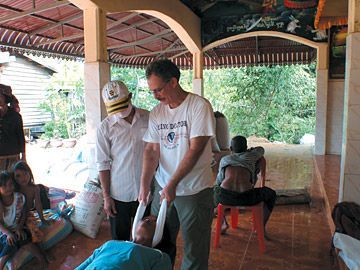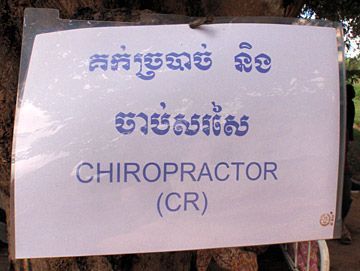New York's highest court of appeals has held that no-fault insurers cannot deny no-fault benefits where they unilaterally determine that a provider has committed misconduct based upon alleged fraudulent conduct. The Court held that this authority belongs solely to state regulators, specifically New York's Board of Regents, which oversees professional licensing and discipline. This follows a similar recent ruling in Florida reported in this publication.
Outside the Comfort Zone: Flying Doctors of America in Cambodia
For many chiropractors, success is about comfort, predictability and ease. We strive to make our practice run smoothly, with as few ups or downs as possible. What if you were to purposely throw a monkey wrench into your daily routine? Willingly put yourself into a practice setting that was uncomfortable, ill-equipped and unpredictable?
Sound appalling? Stop reading right now. Sound appealing? You might be a candidate for a Flying Doctors mission! Flying Doctors of America is a non-governmental organization that runs non-sectarian health care missions to Third World countries. Think "Doctors Without Borders," but a one- to two-week commitment versus a one- to two-year commitment, and mostly safe countries versus some of the most dangerous places on Earth.
Each Flying Doctors mission is composed of volunteers who are willing to practice without the amenities (or restraints) of our modern, high-tech health care system. Mission sites are selected by a board of directors, each of whom leads at least one mission each year. Locations are selected based a number of different considerations including cooperation from the respective country's ministry of health, logistical assistance available on the ground, and safety. Missions usually involve one to two days of travel, four to five days of clinics and one to two days of exploring archeological and historic sites.
Mission to Cambodia

Each volunteer contributes to cover the costs of transportation, lodging, food, logistics and administration. I raised money for my latest mission by soliciting donations from colleagues and vendors. My office also ran a Flying Doctors Day: new and established patients could receive chiropractic services in exchange for a donation to Flying Doctors. Our team featured three surgeons, five MDs, six nurses, two dental professionals, two non-medical spouses, one physician assistant and me - the chiropractor.
Our mission destination on this occasion was Cambodia, one of the poorest countries in the world. Eighty-five percent of the population is subsistence farmers or fisherman trying to get by on about $1 a day. Cambodia was thrown into an extremely dark period in the 1970s, and it is still struggling to recover. The Khmer Rouge regime of the ultra-Maoist dictator Pol Pot devised a plan to turn the country into an agrarian utopia. Pol Pot cut off foreign trade, closed down the banks and universities, and then took anyone with an education or money and had them executed or forced into labor camps. The horror of the Killing Fields is fading from the national psyche, but economic recovery is stymied by corruption and lack of infrastructure and education.

The first rite of passage on our Cambodian mission was a one-stop flight from Atlanta to Siem Reap, Cambodia that took 24 hours. You feel more like a prisoner than a passenger in economy class. At least they let prisoners lie down to sleep. The following day, I joined our team leader, an anesthesiologist who specializes in pain management, at the local hospital. Our job was to perform screening exams on about 100 patients for the ENT surgeons. I was soon busy palpating goiters, checking for broken eardrums, inspecting nasal polyps and scoping infected tonsils. My partner nearly dropped his otoscope when he heard the pop as I performed an auricular adjustment on a patient complaining of fullness in the ear.
Our next day was designated as a rest day so everyone could get their biological clocks in sync. My wife, Dixie, and I were already recalibrated to Cambodian time, so we opted to hold an impromptu chiropractic / acupuncture clinic in the courtyard of the Siem Reap hospital where our surgical team operated.
"How will you explain to people what you are going to do, we don't speak Cambodian?" Dixie asked me. "Just lie down on the table, and I will start working on you. They'll get the idea," I replied. Dixie and I got translation help from a university student named Kosal who speaks some English. Soon we had people crowding around, curious and eager to be next. Folks on crutches, wheelchairs; there was even a fellow without any legs in a wagon circling the portable chiropractic table.
One of the things that I love about practicing chiropractic on missions is that bedsides being a wonderful healing, it also makes great entertainment. People love to see and hear the groans, moans, winces, cracks, pops and smiles. After we have treated about 40 patients, we are ready for a break. Kosal invited us back to his home for lunch. We were excited to see how a Cambodian family lives, so we accepted his offer.
His place looked like a studio apartment for one, but we soon found out that his mother, aunt, sister and two brothers all shared the 12' x 20' room. The only furniture: a bed and a plastic stool. Lunch was prepared and served on the floor. We realized that given these conditions, we were exposing ourselves to a host of microorganisms, but figured that our medical compatriots would help us if we got in trouble.
We were treated to a traditional Cambodian dish called amok. It is chicken with rice and vegetables, cooked in coconut milk and lemongrass, and it is served in a woven banana-leaf basket. Wow, was that spicy, but really tasty. It didn't seem to make us any sicker than any of the other food we had eaten since we arrived. (For the entire mission I fought a stomach ache, nausea, fever and malaise on a daily basis. Not enough to knock me out of commission, but just enough to make me feel like I was hitting on only two pistons most of the time.)
The next four days, we boarded a bus each morning and traveled to different villages on the outskirts of Siem Reap. With the help of interpreters, we would triage the awaiting throng of villagers and assign them to our clinics. We had general medicine, OB/GYN, pediatrics, dentistry, pharmacy and chiropractic / acupuncture. We had no X-rays, no lab tests and no specialized equipment. All the doctors and nurses must rely on a scant history, a few physical findings and their intuition. One doctor said, "This is like practicing veterinary medicine!"
I have been in active practice since 1986, and have volunteered at inner-city clinics and rural settings in Peru, Guatemala and Vietnam. Nonetheless, there were some unique patient encounters in Cambodia, including adjusting the blind and villagers who had limbs missing from landmine explosions; diagnosing Parkinson's disease in a farmer; improvising a splint for a little girl who had been run over by a motorbike; and performing acupuncture on a Buddhist monk.
Each day I ended up hot, sweaty, smelly and dirty. A hot shower, clean clothes and a cold beer were anticipated rewards for my work. I felt very fortunate that I had these waiting for me back at our hotel, and at the same time saddened because the patients I had seen during the day had no such respite from their daily life.
On our last day I was able to realize a long-awaited dream: a visit to Angkor Wat. I had first gazed on the sublime temples of Angkor Wat in a book of poems by Alan Ginsburg back in 1972. Since those teenage days, I have wanted to explore these mystical ruins. Angkor Wat ranks among the world's most magnificent treasurers, on par with the pyramids of Giza, Machu Picchu and the Taj Mahal. If you have ever seen the movie, "Lara Croft: Tomb Raider" then you have caught a glimpse of the Buddhist temples being engulfed by the jungle.
Volunteerism Has Its Challenges and Its Rewards
Mission trips can be exotic, exciting and exhausting. You work long hours alongside many fine professionals who share a passion for adventure and helping the poor. You may have the honor of treating native people with a heritage that goes back thousands of years. But let me caution you - more than once I have returned from a mission feeling disenfranchised from my practice and my culture.
In the Third World countries where I have worked, the people do not have material possessions to make them happy, so they rely more on their interpersonal relationships. What little they do have they seem to be more willing to share. It doesn't seem like that here in the U.S. But despite our materialism, we do promote humanitarianism. The U.S. produces many fine individuals who give of themselves to people of different races, cultures and religions.
There are many ways that doctors of chiropractic can volunteer their services both at home and abroad. Several chiropractic colleges and chiropractic mission organizations send students and licensed DC's to places in the Caribbean, Latin America and Asia. Mission trips coordinated by churches and other religious organizations are beginning to include chiropractors as part of their medical teams. Locally, you can find homeless shelters, group homes and charities that will consider including chiropractic in their package of services.
We have a safe, drug-free method of alleviating human suffering that can help so many people. When you volunteer, you help grow your profession, your practice and your soul.
Author's note: I would like to recognize Lhasa OMS, Lifetimer Tables, Cryoderm, Dee Cee Labs and Bettis Electrical Contractors for their donations, as well as my colleagues and patients who gave their support.
For more information on Flying Doctors of America, visit [url=http://www.fdoamerica.org]http://www.fdoamerica.org[/url]. Dr. Schantz has written about his experiences with Flying Doctors of America on several occasions including 1997 ("Chiropractic at 11,000 Feet: Flying Doctors of America," Jan. 1 issue, detailing his mission trip to Chinchaypucjio, Peru) and 2004 ("Mayan Healing: Mission Trip to Guatemala," May 20 issue).


